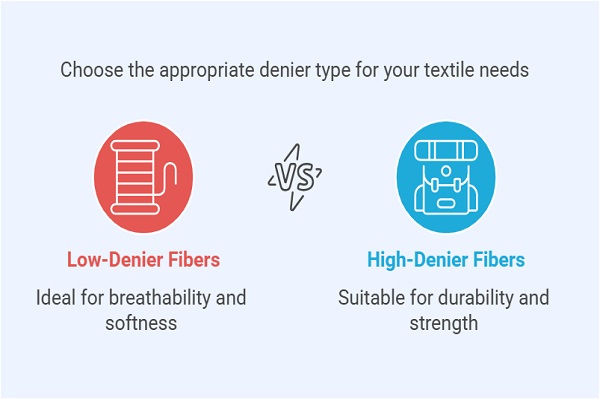Denier Calculator
© Yarn Count Ltd. Disclaimer: All Tools in the Yarn Count have been reviewed by the relevant spinning industry experts.
The formula for Denier:
Denier= Weight (grams)÷Length (meters) × 9000
Where:
- Weight (grams): The mass of the yarn in grams.
- Length (meters): The length of the yarn in meters.
- 9000: A constant used to define denier, representing the length in meters per 9 kilometers of yarn.
Table of Contents
What Is Denier in Textiles?
Denier is a unit that measures the thickness and weight of fibers used in textile production. It indicates the mass of a fiber in grams per 9,000 meters of its length. A higher denier means thicker and heavier fibers, while a lower denier indicates finer and lighter fibers.
How Denier Is Calculated
Denier is calculated using a simple formula:
Denier = (Weight of Fiber in Grams / Length of Fiber in Meters) x 9000
For example, if 9,000 meters of a fiber weigh 30 grams, the fiber is 30 denier.
Types of Denier

Denier varies based on fiber type and application. Common categories include:
1. Low-Denier Fibers
Low-denier fibers are fine and lightweight. They are often used in:
- Sheer fabrics: Such as stockings and lightweight curtains.
- Athletic wear: For breathability and comfort.
- Microfiber cloths: For cleaning applications due to high surface area.
2. High-Denier Fibers
High-denier fibers are thick and heavy. They are used in:
- Outdoor gear: Like tents and backpacks for durability.
- Upholstery fabrics: To resist wear and tear.
- Industrial textiles: For strength in ropes and nets.

Denier and Fabric Performance
Denier directly affects fabric characteristics such as:
1. Durability
Higher denier fibers are more durable and resistant to abrasion. Outdoor and workwear fabrics often use fibers with higher denier counts.
2. Softness
Lower denier fibers create softer, more comfortable fabrics, making them ideal for garments like lingerie and baby clothes.
3. Opacity
Higher denier fibers result in less transparent fabrics, important for clothing items like leggings and curtains.
4. Breathability
Lower denier fibers enhance breathability by allowing better air circulation, commonly used in athletic apparel.
Common Applications of Denier in Textiles
Denier measurements influence the choice of fibers for various textile applications:
- 5 to 15 denier: Fine hosiery and sheer curtains.
- 20 to 40 denier: Lightweight apparel like blouses.
- 50 to 100 denier: Activewear and casual clothing.
- 200+ denier: Luggage, tents, and upholstery.
Factors Affecting Denier
Several factors can influence the denier of textile fibers:
- Material type: Polyester and nylon often have higher denier values than natural fibers.
- Spinning technique: Methods like air-jet spinning can alter fiber thickness.
- Fiber blending: Mixing fibers of different deniers can achieve desired fabric properties.
How to Choose the Right Denier for Textiles
Choosing the correct denier depends on the fabric’s purpose:
- For apparel: Lower denier ensures comfort and softness.
- For outdoor use: Higher denier provides durability and strength.
- For cleaning cloths: Medium denier offers a balance of softness and cleaning power.
Denier in Synthetic vs. Natural Fibers
Denier applies more commonly to synthetic fibers like nylon and polyester. Natural fibers, such as cotton and wool, are measured differently but still follow similar principles for thickness and weight.
Synthetic Fibers
- Polyester: 20 to 400 denier for garments and gear.
- Nylon: 15 to 500 denier for hosiery and outdoor equipment.
Natural Fibers
- Cotton: Not traditionally measured in denier but comparable for blending.
- Wool: Finer wool fibers are similar to low-denier synthetic fibers.
Conclusion
Denier plays a key role in determining textile performance, influencing factors like durability, softness, opacity, and breathability. Understanding denier helps in selecting the right fibers for specific applications, from delicate garments to heavy-duty outdoor gear.